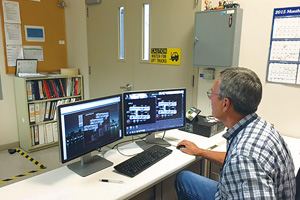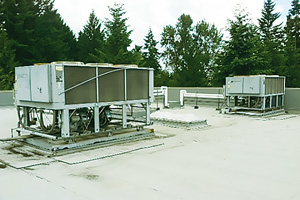Case study - Production
- Topic 1 : Energy Saving in Utility Facilities
- Topic 2 : Updating to a More Efficient Cogeneration System
- Topic 3: Visualizing Air Conditioning to Help Reduce CO2 Emissions
- Other Case Studies
Topic 1: Energy Saving Initiatives in Utility Facilities1
At Suwa Minami Plant, Epson collaborated with Chubu Electric Power Miraiz Co., Inc. to implement energy conservation and decarbonization initiatives from 2018 to 2023. As a result, by fiscal 2023, the plant achieved an energy reduction of approximately 12.3% (equivalent to 2,846 kL of crude oil per year) compared to the base year of fiscal 2017, reducing annual emissions by approximately 4,745 t-CO2.
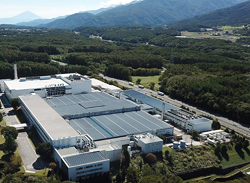
Main Initiatives
- Clarified the process for achieving targets by formulating a roadmap
- Introduced 123 out of 273 energy-saving measures, with 71 still planned and 79 abandoned.
- We are focusing on the three areas below to save energy.
(1) Changing existing equipment and facility operations
Example) Reducing the number of fan filter units in production cleanrooms
(2) Utilizing unused heat
Example) Utilizing unused heat in municipal water
(3) Updating equipment
Example) Selecting high-efficiency equipment when updating to electric air conditioning systems in cleanrooms or when updating boilers and turbo refrigerators
1 Infrastructure and equipment necessary for factory operations, such as electricity, water, HVAC systems (including boilers and chillers), gas, and chemical supply systems required to maintain the factory environment
Recognized with the Energy Conservation Grand Prize (Best Practice Category)
Epson was awarded the 2024 Energy Conservation Grand Prize in recognition of the energy-saving initiatives it launched across its plants and offices under management leadership and for collaborating with partners to identify and implement effective measures for achieving energy efficiency while maintaining manufacturing and development environments. With support from Chubu Electric Power Miraiz, which provided expertise in energy use, Epson developed a decarbonization roadmap, created energy-saving proposals, dispatched personnel, outsourced energy measurement, and implemented training on energy-saving methods.

Energy Conservation Grand Prize (Best Practice Category)
Epson was awarded the 2024 Energy Conservation Grand Prize in recognition of the energy-saving initiatives it launched across its plants and offices under management leadership and for collaborating with partners to identify and implement effective measures for achieving energy efficiency while maintaining manufacturing and development environments. With support from Chubu Electric Power Miraiz, which provided expertise in energy use, Epson developed a decarbonization roadmap, created energy-saving proposals, dispatched personnel, outsourced energy measurement, and implemented training on energy-saving methods.

Topic 2: Upgrading to a More Efficient Cogeneration System1
The Suwa Minami Plant, where Epson manufactures core devices such as high-temperature polysilicon TFT LCD panels for 3LCD projectors and PrecisionCoreMicroTFP printheads, is one of Epson's most energy-intensive facilities in Japan. Theplant had used a cogeneration system (CGS) to generate between 40% and 60% ofits power needs since 2001, but in May 2014, Epson replaced that CGS with threenew high-efficiency CGS. The new systems use less natural gas to operate andreduced the plant's CO2 emissions. The use of the three new CGS makes the overallsystem easier to maintain and provides a steady supply of electrical power.
1 Cogeneration systems, also known as combined heat and power, utilize a single fuel source to produceand supply both electricity and heat.
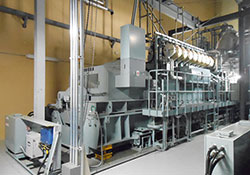
CGS Overview
| Energy output | Units | Model | Fuel | |
|---|---|---|---|---|
| New | 2,270 kW | 3 | Gas engine | Natural gas |
| Old | 7,200 kW | 1 | Gas turbine | Natural gas |
Annual savings (by switching to a gas engine from a gas turbine system)
Amount of natural gas saved: 1,480,000 Nm³
Reduction of CO2 emissions: 4,900 tons
Benefits of CGS
Whereas about 60% of the energy generated by a typical power plant is lost as waste heat and during transmission, only about 15% to 30% of the energy generated by an on-site CGS is lost as waste heat. In addition to generating electricity, CGS also save energy because they effectively recycle about 30% of the waste heat into energy for heating or cooling.
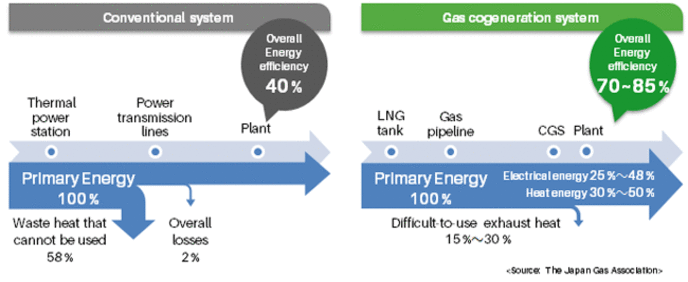
Topic 3: Visualizing Air Conditioning to Help Reduce CO2 Emissions
Epson Portland Inc. (EPI), in the US, has the important role of manufacturing Epson ink cartridges and other products for the Americas. The manufacturing process for Epson inkjet printer cartridges requires a clean room environment to ensure the levels of quality where more than 7 million kWh are consumed each year, on average, for air conditioning and production support equipment.
In 2011, the Facilities team worked with the non-profit Energy Trust of Oregon to introduce a new air conditioning monitoring system to reduce EPI's energy use and environmental impact. The monitoring system allowed Facilities to observe and record the actual air temperatures in the ink cartridge production areas throughout the day.
EPI used the data to qualify the modification of the air conditioning system so that, when outdoor temperatures are lower than thosein the production areas, warm air is automatically exhausted and outside air is used for cooling, saving energy and money. Theseactions have helped EPI reduce its annual CO2 emissions by more than 100 tons.
Since implementing this cooling system in 2011, EPI has taken advantage of various other energy conservation opportunities. Thesehave resulted in cumulative CO2 reductions of approximately 655 tons.
